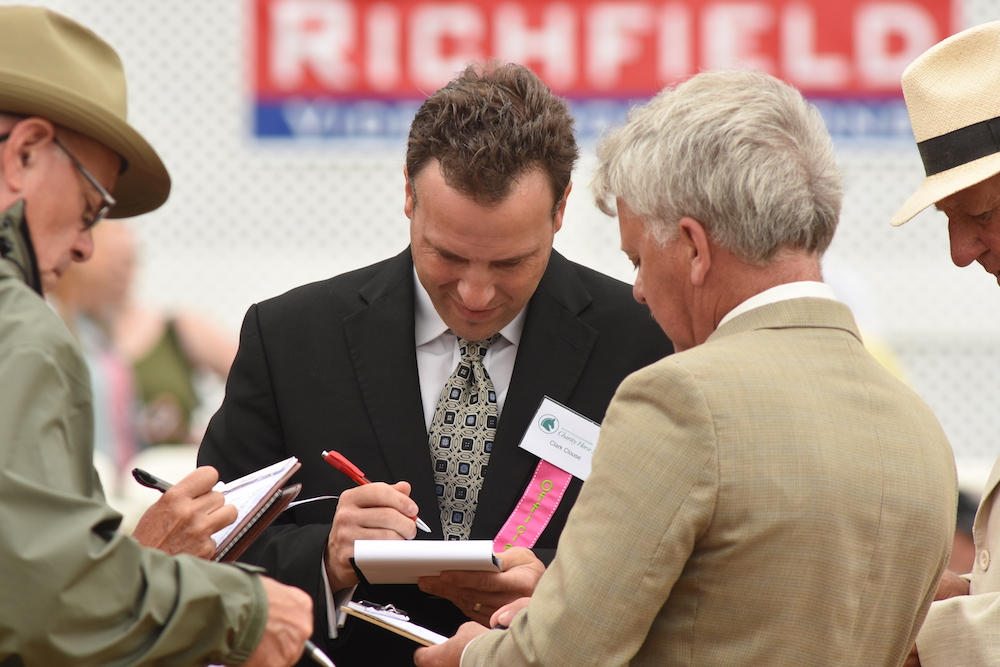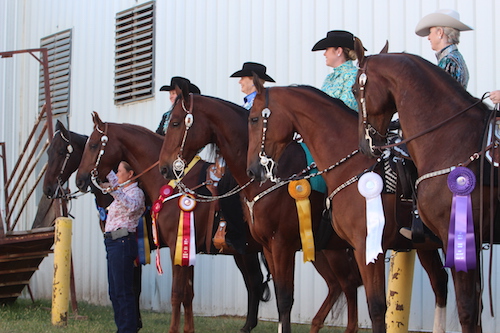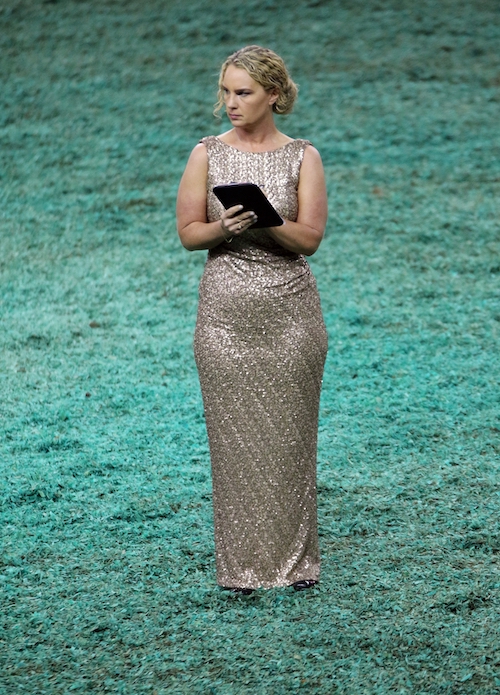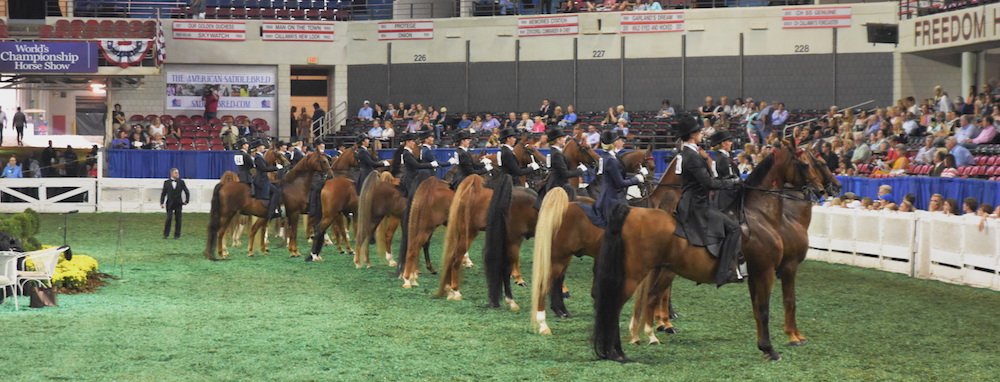 You bring your horse down from the canter and prepare for the final trot into the line-up. The class is over, and as you join the other horses and riders in center ring, you’re mentally walking through your performance – every canter lead and gait change. You guys did great, except for that one little flub, but you don’t think the judges noticed. Just a few more steps, and you’re next to the other horse and rider combinations. That’s when you look down, contemplating how you will smile humbly and accept your ribbon, when you notice in horror just how dirty your boots are. Maybe the judges won’t care. At least, you hope they don’t.
You bring your horse down from the canter and prepare for the final trot into the line-up. The class is over, and as you join the other horses and riders in center ring, you’re mentally walking through your performance – every canter lead and gait change. You guys did great, except for that one little flub, but you don’t think the judges noticed. Just a few more steps, and you’re next to the other horse and rider combinations. That’s when you look down, contemplating how you will smile humbly and accept your ribbon, when you notice in horror just how dirty your boots are. Maybe the judges won’t care. At least, you hope they don’t.
The first ribbon is given out. Then the next, and the next. And suddenly, you’re leaving the ring without the ribbon you thought you deserved; you thought you had earned it.
Apparently, the judges thought otherwise.
You want to know what went wrong, but are you even allowed to ask the judge for feedback? You can, but industry experts say that the process should always be approached carefully and in the proper spirit.
The rules
During a show, there are rules for how and when exhibitors can talk to judges. Kent Swalla, United States Equestrian Federation judge, World Cup committee member and owner, trainer and instructor at Glendale Stables, stresses the importance of following these rules when approaching judges for feedback.
 “I think the proper thing to do is always to ask the management or the horse show steward to speak with the judge, but I’m not opposed to anyone asking me by any means,” he said.
“I think the proper thing to do is always to ask the management or the horse show steward to speak with the judge, but I’m not opposed to anyone asking me by any means,” he said.
According to USEF rules for competition participants, found in section GR1304, “No one shall approach a judge with regard to a decision unless he first obtains permission from the Show Committee, steward or technical delegate who shall arrange an appointment with the judge at a proper time and place. No exhibitor has the right to inspect the judge’s cards without the judge’s permission.”
Of course this only applies to USEF licensed competitions. At non-USEF shows, Kent said, though it isn’t required, it is nice to ask the horse show management. There are no rules that prevent an exhibitor from approaching a judge once either type of competition had officially ended.
The proper approach
When approaching a judge, Richard Wright, trainer and owner at Black Tie Stables said, be courteous and prepared.
After the show, Richard said, it is common for competitors to thank the judge for their efforts and coming to judge their horses. This does three things – first, it allows the competitor to genuinely thank the judge; second, it gives the judge and competitor an interaction; and third, it serves to help remind the judge who the competitor is for any after-the-show following up.
Before making the decision to approach a judge, Richard, who serves on the USEF and UPHA equitation committees, is a World Cup Trial judge and has judged in both Canada and South Africa, suggests seeing if you have access to video footage of the class, and watching it.
“You might realize you don’t really want to make a call,” he said.
He prefers digital contact, through email or Facebook first, rather than a phone call, where the rider is specific about who they are, who their horse is, what class they were in and any memorable activities that happened during the class.
“Not every judge remembers, and not all judges remember a horse by their number,” he added. “Give the judge enough information to recognize the horse… or what color suit the person had on… so someone who doesn’t know you and doesn’t know your horse can figure out who you were.”
Being respectful of the judge, and their time, and keeping in mind that their job was over once the show was over, is imperative.
Feedback after the show – whether it is asking if your horse shows potential, or should have been higher-headed or lower-headed, faster or slower – will help the rider, if the rider contacts the judge with an open mind, Richard said.
“Ask for feedback on what was bad to use as a learning tool,” he said. “The number of people who want to call a judge after a show to explain to them how wrong their decision was, well, that is never a good decision.”
Mary Orr, USEF judge and William Woods University alumni, suggests riders wait long enough to contact a judge to give perspective, but not enough time to be forgotten.
“We’re very passionate about what we do, and that gets in the way as an exhibitor,” she said. “When you’re proud of what you’re doing and disagree with what they did, you want to know why, and that’s difficult to not take it personally.”
Mary, who runs a large-scale riding program and show barn at High Caliber Stables, has benefitted from being both a judge and a competitor.

Her first time judging, someone who disagreed with her approached her as she was walking out of the arena and was aggressive in their disagreement.
“It changed me as an exhibitor, because I had never been on the other side of it,” she said. “It really took me back, and I think that the approach was more the issue, not the question. For a judge, it’s not someone asking you, it’s the way you present yourself.”
A difficult job
Kent believes that many people don’t realize how much detail goes into judging. For example, when walking the lineup, Kent said that the judge has to evaluate small, easily overlooked details such as if the tie downs are not tight, if the rider’s pants are loose, if their boots are dirty, or the stirrup leather is in front of the knee.
“That’s a big part of judging that I don’t think audiences always recognize; the judge is making the decision based on the time that he has, but you also have to pay attention to where he’s looking and what he’s judging, and not just watch one horse,” Kent said. “Your horse may have had a good go, but that doesn’t mean the others weren’t better or the judge didn’t see someone else’s mistake because was he watching something else.”
Often, if a parent wants to know why their child did not get a better ribbon, he first asks if the parent was watching their child, or the entire class. A class can sometimes have 20-something riders in the ring, and decisions have to be made quickly based on the criteria of the class, what the class is; it isn’t judging in isolation, and it isn’t easy.
“You have to really love judging,” Kent said. “I think it is very important.”
The equestrian industry, he said, has given him so much, and being able to give back through judging, and helping riders improve, while upholding the standards of the sport, is something he is proud to do.
Many competitors, he said, are not aware that there is a great deal of continuing education required for judges, as they are protecting the integrity of the sport through the criteria of the class and the greatness of the breed through their judging.
“Every day is a new day and every day is a new learning curve,” Kent said. “You can learn something every day, as long as you’re willing to.”
The problems with feedback
One judge, competitor, instructor and industry expert who has never stopped learning is Gayle Lampe, William Woods University professor emeritus of equestrian studies, the only equestrian inductee to the Missouri Sports Hall of Fame and 2018 inductee into the International Saddlebred Hall of Fame.
“Gayle is one of the most influential equestrian people in the world,” Richard said. “She crosses all lines of breed specificity and is an ambassador for the horse industry worldwide and across all disciplines.”
 With judge’s cards in nine disciplines, Gayle observes that, “the cream usually rises to the top.”
With judge’s cards in nine disciplines, Gayle observes that, “the cream usually rises to the top.”
“The judge’s job is to decide horse A is better than horse B and horse B is better than horse C,” she said.
However, she said that judges might not be able to explain their placements effectively afterwards. By the end of the show they have seen multiple classes, and aren’t necessarily going to remember the first class from four days ago, especially getting down to seventh and eighth place. It’s vital to keep this in mind when asking for feedback.
“When you’re judging, you’re not doing a clinic, you’re simply evaluating,” she said. “It’s a quick glance at somebody. If I wrote a lot of notes, yes, I could give more feedback, but if I’m writing notes, it’s taking too long to judge and I’m not looking at riders, and missing way too much.”
The best way to obtain useful feedback is through a clinic, she added. With clinics, riders receive the feedback immediately, and in more detail.
And in competition, Gayle stressed, you don’t want to constantly change to please every judge anyway. You want to ride how your instructor taught you, and ride the best you can.
“Each time you show, you don’t want to fix yourself to suit the judge that’s judging,” she said. “If you do, then you don’t have a style.”
In short, judge feedback can be a useful learning tool, but should always be taken with a grain of salt. One of Gayle’s favorite explanations of this concept comes from trainer Dale Pugh.
“He always said, you don’t want to go ask the judge why they didn’t tie your horse. Because you know your horse. You train your horse every day. You know what is good and what is bad about your horse. You ask a judge who saw your horse for 10 seconds, 30 seconds, because he was looking at tons of other horses at the same time in the class, and he’s going to tell you what he doesn’t like about your horse. And it’s going to make you really mad, because it’s going to be the horse’s best feature,” she said. “The judge may say something to say something, but it will be something stupid and just make you madder.”



